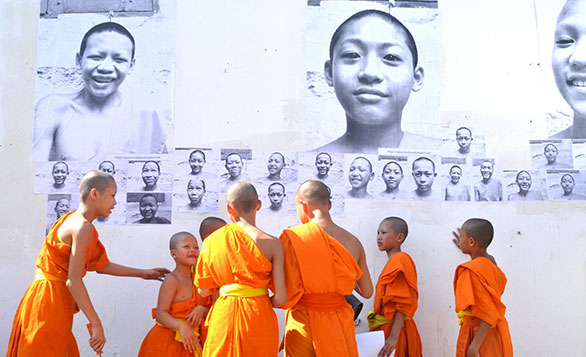
JR’s TED Prize wish — to turn the world Inside Out through portraits — has led to more than 250,000 posters created and pasted on walls in 124 countries, from New York to Nepal. Photo: Aline Deschamps
The TED Prize turns our staff into genies: every year, we give $1 million dollars to one inspiring leader with a bold wish for the world. A sampling of wishes that have won in recent years:
“Help us spark a global movement to record and preserve meaningful conversations with one another that result in an ever-growing digital archive of the collective wisdom of humanity.” — Dave Isay, winner of the 2015 TED Prize
“My wish is to help design the future of learning by supporting children all over the world to tap into their innate sense of wonder and work together. Help me build the School in the Cloud.” —Sugata Mitra, winner in 2013
“I wish for you to stand up for what you care about by participating in a global art project, and together we’ll turn the world … INSIDE OUT.” —JR in 2011
Nominations for the TED Prize are now open on a rolling basis. Using our nominations page, you can introduce us to an incredible colleague, friend or mentor — or even nominate yourself. And while the nomination form asks for a range of information, the most vital element is the wish itself.
Below, the anatomy of what makes a great TED Prize wish, to help you craft your thoughts.
The heart of a TED Prize wish: A creative approach to solving a problem.
A great TED Prize wish is a new, fresh way to think about one of the world’s toughest issues. It should be simple and free of jargon. It must be vivid and infused with passion. While it may not eradicate the problem entirely, it offers a way for people to join together and create a movement toward that end. Anna Verghese, Director of the TED Prize, explains, “The wishes that get us excited are the ones that, in a couple of sentences, clearly set out the issue that needs the world’s attention, and provoke you to want to take action on it.” Sarah Schoengold, TED Prize Project Coordinator, adds, “The wishes that excite me most are those that capture my imagination and make me think again. Sugata’s student-centered learning labs — it was easy to picture how they could spiral across cultures. And JR’s wish made us rethink the power of paper and glue. So simple and compelling.”
The brain of a TED Prize wish: A leader with the ability to inspire action.
A key element of a TED Prize wish is that is geared toward action — there is a clearly defined plan for how the wish can be achieved. This means that the ideal TED Prize wish comes from a pragmatic dreamer — someone who has a proven track record in his or her field. We’re looking for a leader who can manage others and who can demonstrate the ability to execute a multi-year project, to budget a million dollar initiative, and to produce measurable results. But beyond being a great strategic thinker, a TED Prize winner must be a great communicator, with the vision to get people outside of their field excited too.
The arms and legs of a TED Prize wish: The TED community.
As soon as a TED Prize wish is announced, it has a global army of willing foot-soldiers: the members of the TED community. This includes not just the TED Prize staff but our international network of TEDx organizers, our diverse community of speakers, the members of our TED Fellows program, and our web of Open Translation Project translators. A TED Prize wish should point towards concrete ways for these communities to get involved. Verghese says, “The TED community’s resources and desire for change provide a wish with that foundation to encourage mass, global collaboration.”
The lungs of a TED Prize wish: The public, at large.
A great TED Prize wish allows members of the public — whoever they may be — to breath fresh air into a field. Take Jamie Oliver’s wish: that families cook together, as a way to teach kids about food. Or JR’s wish: that people photograph themselves and paste the image publicly. These wishes invite people in, give them a way to take action, and let them run wild with creativity. Schoengold explains, “The most powerful wishes ask everyday people to take part in an experiment that will only work with their help.”
Inspired? Nominate yourself or someone else for the TED Prize »
.
Note: This post originally ran in March of 2014. It was updated on December 15, 2015.
Comments (16)
Pingback: The Top 10 TED Talks Every Woman Should See | GIRL CRATUS
Pingback: The Top 10 TED Talks Every Woman Should See | The Joseph Ejiro Blog
Pingback: TED’s 30th anniversary + TOP 10 moments for women in TED | The English Learners' Blog
Pingback: Top 10 TED Talks Women Should See | ac
Pingback: What’s your $1 million wish for the world? Some amazing ideas | Health & Wellness Chicago
Pingback: What’s your $1 million wish for the world? Some amazing ideas | jr
Pingback: What’s your $1 million wish for the world? Some amazing ideas | Cherry Wired
Pingback: What’s your $1 million wish for the world? Some amazing ideas | Best Science News
Pingback: What’s your $1 million wish for the world? Some amazing ideas | BizBox B2B Social Site